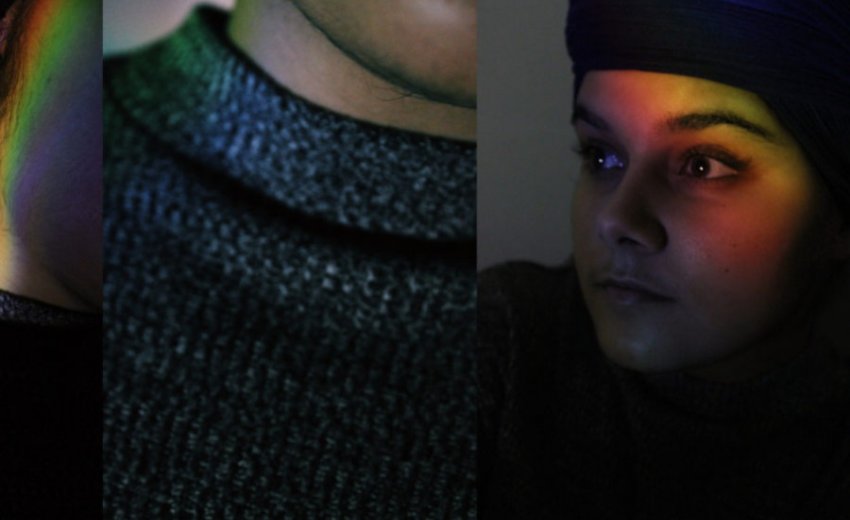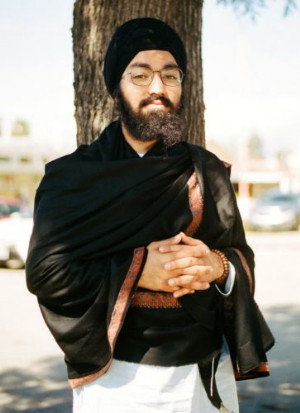CHALLENGING THE GENDERED DOUBLE STANDARDS OF BODY HAIR & KESH
BECOMING WORTHY OF THE GURU’S SOVEREIGNTY–DISMANTLING DOUBLE STANDARDS WITH ਕੇਸ (KESH) & ਰੋਮ (ROM – BODY HAIR)
by ਹਰਨੂਰ ਸਿੰਘ harnoor singh
I have always believed that the ੫ ਕਕਾਰ (panj kakar* – five articles of faith) are gifts from our ਗੁਰੂ (Guru) and the reason to keep them need not be any more complicated than a mind-consuming, maddening love for ਗੁਰੂ ਜੀ (Guru Ji) and ਗੁਰਸਿੱਖੀ (Gursikh). I have always believed that to don these ਕਕਾਰ (kakar) is to accept the responsibility of a sovereign ਖਾਲਸਾ (Khalsa) and thus accept that you must carry on the ਵਿਰਸਾ (virsa – heritage) of ਗੁਰਸਿੱਖੀ (Gursikhi). The motivation for accepting this responsibility and carrying it adequately must be the purest and truest form of love and devotion for the ਗੁਰੂ (Guru).
POLICING OF ਸਿੱਖੀ ਸਰੂਪ (SIKHI SAROOP)
With all of this being in mind, I find it hard to understand why we hold a double standard in regard to who in the ਪੰਥ (panth) should keep their ਕੇਸ (kesh – unshorn hair). The sovereignty that we are bound to uphold when we accept the gift of the ੫ ਕਕਾਰ (panj kakar* – five articles of faith) is something that the ਗੁਰੂ (Guru) gifts us. However, it seems that specifically the cis-male, heterosexual ਸਿੰਘ** (Singh) of our community are blinded to the hypocrisy of espousing the beauty of being ਕੇਸਾਧਾਰੀ (keshdhari – one who keeps their hair) and the value of maintaining each ਰੋਮ (rom – body hair) on the body while also preferring to have a partner who only has ਰੋਮ (rom – body hair) where it is visually pleasing to them.
How far have we fallen from our sovereignty if we as ਸਿੰਘ (Singh) believe that it is fair for us to encourage our ਬੀਬੀਆਂ *** (bibia(n)) to cut or shave their ਰੋਮ (rom- body hair) to bend to Western beauty standards? Why are the ਰੋਮ (rom- body hair) on one body more visually pleasing than those ਰੋਮ (rom- body hair) that have the good fortune to sprout from the body of a sovereign ਕੌਰ (Kaur) of the ਗੁਰੂ (Guru). The question is why the ਬੀਬੀਆਂ (bibia(an) – women) of our community are discouraged from expressing the very love that the ਗੁਰੂ (Guru) demands of us in order to maintain and cultivate our ਵਿਰਸਾ (virsa -heritage). In my opinion, it seems like the ਸਿੰਘ (Singh) in our community have somehow taken it upon themselves to be the arbiters of who is deserving of the gift of sovereignty from the ਗੁਰੂ (Guru). This is a problem of the utmost importance for the ਪੰਥ (panth). It is absolutely horrible to see that patriarchy has infiltrated the ਪੰਥ (panth) so deeply that we now question whether the equality that the ਗੁਰੂ (Guru) created, by giving sovereignty equally to everyone in the ਪੰਥ (panth), was the right decision. Are the so-called ਸਿੰਘ (Singh) of our community so threatened by the sovereignty of ਕੇਸਾਧਾਰੀ ਬੀਬੀਆਂ (keshdhari bibia(n) – women who keep their hair) that they feel the need to attempt to have ਕੇਸ (kesh – hair) be a ਕਕਾਰ (kakar – article of faith) that is only properly kept by ਸਿੰਘ (Singh)? Such behavior is quite far from deserving of the sovereignty gifted by the ਗੁਰੂ (Guru) and rather raises the question of how deserving these people are of the title ਸਿੰਘ (Singh). Even more relevant is how undeserving those of us who allow this behavior to continue are. This may seem severe, but to question the sovereignty of the ਗੁਰੂ (Guru) is not something to be taken lightly. The likes of ਮੱਸਾ ਰੰਗੜ (Massa Rangar) who have made a mockery of the throne of the ਗੁਰੂ (Guru) have been properly dealt with by true ਖਾਲਸੇ (Khalsa) of the likes of ਭਾਈ ਮਹਿਤਾਬ ਸਿੰਘ (Bhai Mehtab Singh) and ਭਾਈ ਸੁੱਖਾ ਸਿੰਘ (Bhai Sukha Singh).
ABANDONING ਪਾਤਸ਼ਾਹੀ (PATSHAHI- SOVEREIGNTY) &
ACCEPTING ਮਨਮੱਤ (MANMAT – THE OPPOSITE OF GURMAT)
I have always found that the most commonly read ਪੰਕਤੀਆਂ (panthia(n) – verses) of ਗੁਰਬਾਣੀ (Gurbani) are the most forgotten or incorrectly understood. Within ਜਪ ਜੀ ਸਾਹਿਬ (Japji Sahib) , ਗੁਰੂ ਸਾਹਿਬ (Guru Sahib) clearly shows that if one accepts ਹੁਕਮ (hukam – order), we can understand the fact that hair grows naturally on all bodies, then it is not possible to speak out of ego.
ਨਾਨਕ ਹੁਕਮੈ ਜੇ ਬੁਝੈ ਤ ਹਉਮੈ ਕਹੈ ਨ ਕੋਇ।।੨।।
naanak hukamai je bujhai ta haumai kahai na koi ||2||
O Nanak, one who understands the Divine Order/Command, does not speak in ego. ||2||
Ang 1, Guru Nanak Sahib
To put one’s own opinions and judgements above those of the ਗੁਰੂ (Guru) is motivated by one’s ego and the illusion that one is of any sort of authority to declare who is deserving of keeping ਸਿੱਖੀ ਸਰੂਪ. (Sikhi Saroop – the Sikh’s physical form) The other side of this is that many members of our community have been conditioned to understand beauty through Western beauty standards and thus feel it is necessary for our ਬੀਬੀਆਂ (bibia(n) – women) to also match up with this standard. Personal messages that some ਕੇਸਾਧਾਰੀ ਬੀਬੀਆਂ (keshdhari bibia(n) – women who keep their hair) receive would confirm how so many so-called ਸਿੰਘ (Singh) turn a blind eye to their disgusting behavior that objectifies and insult our ਭੈਣਾਂ (bhena(n) – sisters). Such behavior is nothing short of despicable and disqualifying for someone seeking to carry the title of ਸਿੰਘ (Singh). Of course, it is important to point out the obvious point that ਬੀਬੀਆਂ (bibia(n) – women) do not keep their ਸਿੱਖੀ ਸਰੂਪ (Sikhi Saroop – the Sikh’s physical form) for anyone but the ਗੁਰੂ (Guru) and thus no ਸਿੱਖ (Sikh) should feel the responsibility to question, challenge, or insult a ਕੌਰ (Kaur) who has been inspired, by love of the ਗੁਰੂ (Guru), to adopt the form of a sovereign ਖਾਲਸਾ (Khalsa).
POLICING THE ADOPTION OF ਸਿੱਖੀ ਸਰੂਪ (SIKHI SAROOP)
I have been in so many conversations at numerous camps where ਕੇਸਾਧਾਰੀ ਬੀਬੀਆਂ (keshdhari bibia(n) – women who keep their hair) are belittled and mocked for their appearance because they happen to have a few ਰੋਮ (rom– body hair) sprouting from their chin. Why is this so prevalent? Throughout their childhood, ਸਿੱਖ (Sikh) children are conditioned to see this double standard as normal. ਕੇਸ (kesh) is typically only defined through the ਦਸਤਾਰ (dastar) for young ਸਿੱਖ (Sikh) children, whether it be through visual representations or demonstrations of how to maintain ਕੇਸ (rom – body hair). This is not an issue on its own, but the ਦਸਤਾਰ (dastar) has been interpreted and designated to be only for male-appearing folks in our community by those who interpret the sovereignty of the ਗੁਰੂ (Guru) through their own ego. I say this because such beliefs are clearly not in line with our history, and we have numerous examples in our community of ਬੀਬੀਆਂ (bibia(n) – women) that don the ਦਸਤਾਰ (dastar), but they end up being seen as exceptions. By creating this gendered idea of who the ਦਸਤਾਰ (dastar) is for, we also have perhaps granted the power of policing the presentation of ਰੋਮ (rom – body hair) as well.
SUPPORTING OUR SISTERS WHO KEEP THEIR ਸਿੱਖੀ ਸਰੂਪ (SIKHI SAROOP)
There are concrete steps that we can all take moving forward to deconstruct this patriarchal misinterpretation of ਸਿੱਖੀ (Sikh). As I mentioned above, our ਬੀਬੀਆਂ (bibia(n) – women) are verbally assaulted on social media very often and it is imperative that we all, especially ਸਿੰਘ in our community, listen to them when they attempt to call out the perpetrators and serve as allies in challenging patriarchal and misogynistic behavior within our community. Additionally, it is crucial for those with young ਸਿੱਖ (Sikh) children to encourage young ਬੀਬੀਆਂ (bibia(n) – women) to fall in love with ਸਿੱਖੀ (Sikhi) for themselves as opposed to only seeing their ਸਿੱਖੀ (Sikhi) defined through how they support their brothers or future spouses. This is a simple way to enforce the fact that the gift of sovereignty and ਸਿੱਖੀ (Sikhi) were equally given to all followers of the ਗੁਰੂ (Guru). Lastly, and I direct this to my fellow ਸਿੰਘ (Singh) of the community, always make attempts to subdue your ego and be as humble as possible. Do not immediately become defensive and launch full on verbal assaults on anyone who seems to violate your worldview. Always be ready to learn and be corrected.
My humble request to all of us who feel challenged by the words I have put forth in this piece is to question the source of your criticisms whenever you feel motivated to criticize and belittle a fellow ਬੀਬੀ (bibi – women) for their ਰੋਮ (rom – body hair). Question whether you really think ਗੁਰੂ ਸਾਹਿਬ (Guru Sahib) granted us this indescribable ਦਾਤ (dat(h) – gift) of sovereignty for the sake of claiming our ਮੱਤ (mat(h)- wisdom) is superior enough to be the sole arbiter of who deserves the sovereignty of the ਗੁਰੂ (Guru), or perhaps realize that what our ਗੁਰੂ (Guru) called for was a much higher purpose to liberate each other from the structures and forces (ਮਾਇਆ (maya – attachment) and ਅਹੰਕਾਰ (ankar – ego)) that prevent us from seeing the oneness of the ਪੰਥ (panth).
------------------------------------------
*੫ ਕਕਾਰ (panj kakar) are often translated as “five articles of faith” but I prefer to view them as “5 gifts given to the Khalsa by the Guru to create a physical ਸਰੂਪ (saroop) of a sovereign ਖਾਲਸਾ (Khalsa)”.
**ਸਿੰਘ (Singh) – For the sake of brevity, throughout this article, unless stated otherwise, ਸਿੰਘ (Singh) will refer to cis-male, heterosexual-identifying people who self-identify as a ਸਿੰਘ (Singh) of the ਗੁਰੂ (Guru).
*** ਬੀਬੀਆਂ (bibia(n)) – For the sake of this discussion, ਬੀਬੀਆਂ (bibia(n)) refers to people who, due to their gender expression (how they visibly appear), are policed based on normative ideas of gender identity for women (for example, what is seen as appropriately feminine in terms of clothing, facial hair, and use of make-up). In other words, ਬੀਬੀਆਂ (bibia(n)) refers to people who, based on how they look, are excepted by society to act as women.
Harnoor Singh
ਹਰਨੂਰ ਸਿੰਘ (harnoor singh) is a 2020 graduate from the University of Michigan with a BS degree in Sociology and Statistics. His passions lie in realizing the radical nature of the traditions that Guru Ji gave to us in order to actualize the potential of the Panth to create social change and eliminate inequality on many different axes. He hopes to pursue a career that will help him to do work to abolish prisons and assist those communities most targeted by over-policing and over-incarceration.
ਹਰਨੂਰ ਸਿੰਘ (harnoor singh) explains why he does not capitalize his name,” It follows from a convo I had with my Ma about how in punjabi there’s no real upper or lower case so sometimes in translations names can be seen in lower case though, I have no idea how common that is nowadays or previously. Also, this explanation by bell hooks for why she does it really resonates with me: Watkins wanted her pen name to be spelled in lowercase to shift the attention from her identity to her ideas.


